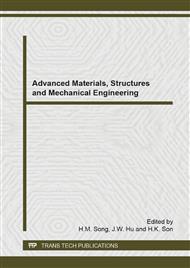p.672
p.677
p.683
p.688
p.693
p.697
p.703
p.709
p.717
Determination of OSB Wood Composites with Resin Derived from a Renewable Natural Resource
Abstract:
OSB (Oriented Strand Board) is the most important development in the industry of wood products in recent years. However, mainly for reasons of cost industries use as adhesive resins that emit formaldehyde. Formaldehyde is considered a hazardous substance and its concentration indoors is restricted in many countries because of its reactivity, toxicity and pungent odor. This study aimed to attest the thickness swelling of the OSB manufactured from resin with part of your component derived renewable resource (castor oil-based polyurethane) and Pinus sp. The panels were produced technically evaluated by determining the thickness swelling property. In comparison to the minimum requirements of the European normative document EN 300 (2006), average values met the requirements for use of the panels and components for general use in dry environment (OSB/1).
Info:
Periodical:
Pages:
693-696
Citation:
Online since:
September 2014
Keywords:
Price:
Сopyright:
© 2014 Trans Tech Publications Ltd. All Rights Reserved
Share:
Citation:


